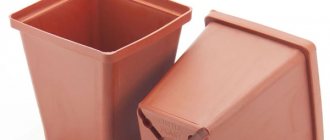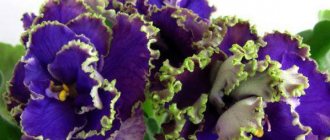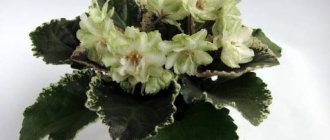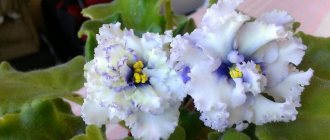Spectacular, charming and compact Uzambara violets have gradually become one of the leading indoor floriculture crops due to their unpretentious nature, fairly simple methods of creating a comfortable microclimate and a wide selection from an innumerable number of varieties and seedlings.
varieties from domestic breeders into their collections , which is explained by the greater adaptability of varieties to local conditions and the native sound of their names. Among the varieties little known to violet lovers, we can recommend Saintpaulia “23-Faberge Smile”, which stands out for its exquisite shape and coloring of the corollas.
Diseases and pests
If the violet is properly cared for, it rarely suffers from pests.
Diseases in these plants may be as follows.
- Fusarium. This is rotting of the root system, degradation and softening of the leaves. It is not possible to cure violet.
- Gray rot. Appears when the soil contains excess moisture. You should treat the flower with “Fundazol”, stop watering, sprinkle with rubbed charcoal and transplant into another container.
- Powdery mildew. Quite a dangerous disease. A fine white rash similar to talcum powder appears on the leaves. The violet should be treated with Topaz; there are also other fungicides.
- Mite. A pest that multiplies quickly and can spoil several violets at once. When it occurs, the leaves become covered with a yellowish coating and fall off. Such parasites appear as a result of a dry room and too high a temperature. You should make a solution of laundry soap and wipe the leaves and stems with it.
- Thrips. This is another dangerous pest that can attack the plant if there is not enough humidity in the room. In this case, Saintpaulia should be sprayed with insecticides “Aktellik”, “Inta-Vir”, “Fitoverm”, “Aktara”.
- Nematode. If you start a violet infected with a nematode, the plant will have to be eliminated (along with the soil and container). But if the violet has just “picked up” such an infection, then it should be treated with Fitoverm.
- Aphid. Treatment should begin as soon as the first signs of infection become noticeable. Signs of aphids: leaves turn yellow, gray, brown. It is treated with the same drugs as in case of tick infection.
7 photos
As preventive measures, the plant should be exposed to diffuse lighting (at least 12 hours daily), fed with various chemical compounds, and watered in a timely manner. In addition, be responsible for the propagation of violets and the composition of the soil. If there are any signs of illness, immediately isolate the plant by moving it to another room.
For information on the soil and volume of dishes for Saintpaulia, see the video below.
Description
The variety “EK-Bullfight Gold” stands out among others. It is an indoor plant with fairly large double star-shaped flowers of a rich “bloody” color. Depending on the nature of the lighting in the room, violet delights the eye with the most incredible shades. In bright light the flowers become bright scarlet, and in cloudy weather they turn brown and ruby.
A distinctive feature of this variety is year-round flowering. First, the rosette produces two or three low peduncles with a pair of buds on each. As soon as they begin to open, three more are formed. The result is a huge bouquet with flowers up to 8 cm in diameter.
The Saintpaulia rosette is flat and quite dense. With proper care and timely application of fertilizers, the plant reaches 30 cm in diameter. The leaf blades are large, slightly elongated, with a light wavy edge. Color – rich green.
"Bullfight" is a capricious plant. Most flower growers note the instability of its flowering, and doubleness often appears only on the third casting of peduncles, although there are cases when the rosette produced a double flower the first time. In addition, facts of alternation in the quality of the flowers themselves between individual blooms are recorded.
Another unpleasant feature of this Saintpaulia is the frequent yellowing of the leaves in the bottom row. Often the leaf plates located at the bottom of the rosette turn yellow and quickly die after the next bud opens. Moreover, this process does not depend in any way on the level of illumination, temperature conditions and irrigation features. This also does not mean that the plant has encountered a disease. That’s just the nature of Saintpaulia Bullfight.
Violet RM-Faberge (N. Skornyakova)
RM-Faberge, a variety of Usambourg violet from the genus of hybrid Saintpaulias, which belong to the Gesneriev class. Bred by breeder N. Sornyakova.
Faberge's fabulous violet.
The rosette is standard in size and type of growth. The leaves are not very large on elongated cuttings. The plate is slightly wavy along the edge with a clear vein pattern. The color is light green, becoming lighter as it grows (young leaves can be bottle-colored).
Violet flowers:
- Large;
- Terry;
- Very clear;
- And beautifully shaped.
The petals are slightly wavy, but not corrugated, and wide. The color is very exciting and attracts attention with its fantasy.
Three colors are intertwined on the flower
- The main one can be considered fuchsia pink;
- It is diluted with white in the center of the flower and a small rim around the edge;
- And the palette is complemented by fantasy blue, which splashes onto the pink.
This variety has an unusual flower color.
Important! Depending on care, the amount of white can vary, from a small spot in the center, to white petals with a pink print (on which the fantasy is preserved).
The variety has no fixed sports . But taking into account the external parameters of the flowers, there is a possibility of getting a baby with white and pink flowers without fantasy, or plain petals of one of the colors. Sometimes such varieties produce chimeric sports, but this is rare.
Wild rock violet
Synonyms. Sand violet (V. arenaria).
The leaves are small, round, heart-shaped at the base and obtuse-angled at the top, hard, with long petioles, arranged alternately on the shoots. Long peduncles with medium-sized (12-17 mm long) flowers with a small spur emerge from the leaf axils.
Growing conditions. Under natural conditions it grows on dry slopes, fields, wastelands and light pine forests. Prefers sandy, rocky or calcareous soil.
Use: Rarely used in culture. Can be cultivated in natural style gardens, planted in clumps under a sparse canopy of trees, on dry edges, lawns and rock gardens.
Care
Violet "Angelica" is a fairly hardy plant that is not afraid of pests, but in order for development to occur normally, it is necessary to create normal conditions and do proper care
Here are the most important parameters that we recommend you pay attention to:
- degree of illumination;
- indoor humidity level;
- water temperature during irrigation;
- temperature during the day and at night.
Caring for flowers is not particularly difficult. The optimal temperature should be +18-23 degrees Celsius. To do proper watering, you should prepare appropriate trays; excess moisture accumulates in them for a short time and then evaporates. When watering, you need to monitor the water temperature, it should be at least +18 degrees. It is permissible to water the plant while the soil is drying.
For comprehensive lighting, it is recommended to rotate flower pots around their axis from time to time. Saintpaulia can bloom all year round; for this it is recommended to use artificial lighting. It is best to use fluorescent lamps or phytolamps. The flower does not tolerate direct sunlight and reacts extremely negatively to cold drafts, so take care of diffused light and warm space.
In the cold season, lighting should be present for 10 hours (this is the minimum), the room temperature should not fall below +15 degrees. In the winter months, the volume of watering is limited to twenty percent.
Combined soil is usually used, where there are:
- leaves;
- turf;
- needles;
- peat
The ratio is 3: 2: 1: 1, baking powder is also often added:
- perlite;
- vermiculite;
- sand.
Application of various fertilizers is permissible at least once every 2-3 weeks. Fertilizing should be done during the growing season. Thanks to proper feeding, the plant looks healthy and blooming. During the initial period of development, violets require nitrogen supplements; adult plants additionally require phosphorus and potassium.
Specialized stores sell special additives for Saintpaulia; when purchasing, it is recommended to consult with the seller. Fertilization is completed at the end of September - beginning of October, the plant must gain energy and rest in order to fully enter the winter period.
Replanting should be done every 12 months, while the root system should remain in a coma of earth. To successfully perform such an operation, you should additionally purchase large ceramic or plastic containers. Small holes must be drilled in all vessels, then full air exchange will be maintained.
Often, gardening associations and stores offer special pots for Saintpaulias. Such devices have special drainage holes through which excess moisture comes out.
The minimum size of a pot for violets can be about 65 mm in diameter, the second container should be 80-100 mm
It is important that the soil meets all requirements, otherwise the plant will not be able to fully develop. The soil acidity level should be between 5.6-6.6 pH
The soil sold in the store is labeled “Saintpaulia” or “violet”. Such a product requires improvement; certain additives should be added.
Caring for a plant at home
In care, it is important to find your ideal conditions, because the color of the flowers directly depends on the temperature and content.
Location
When choosing a place, it is better to give preference to the top shelves on the racks and warm window sills :
- Lighting – bright, without direct sunlight;
- The temperature varies from 16 to 26° . The cooler the conditions, the brighter the pattern, the larger the border and the lighter part on the petals. In hot weather, the border disappears completely. Many gardeners maintain a standard temperature, regardless of the season, approximately 24°;
- Air humidity does not affect color, but it is important to maintain 60%, lowering it to 40% in winter, and increasing it to 70% in summer. At a constant temperature, the humidity should be stable.
Transplantation, pruning, rejuvenation
The rosette must be trimmed regularly for hygiene purposes, removing all old, diseased, yellowed leaves and faded flower stalks. In addition, pruning is carried out for:
- Reproduction;
- Or during a transplant.
Violets need to be replanted once a year.
Transplantation is carried out in two cases:
- To enlarge the flowerpot , usually in the first 1.5-2 years, as the plant grows. To do this, simply transfer the rosette with a lump of soil into a new pot;
- To change the soil (in the treatment of diseases). It is recommended to replant once a year (if necessary). For this:
- The plant is taken out of the pot and all the soil is shaken off;
- Trim damaged roots and lower rows of leaves;
- Soil is poured into the same container (if the rosette is not sick, otherwise the pot is changed) and a violet is planted in the center.
Soil for violets is used purchased, specialized, for Saintpaulias. If you make the substrate at home, you need to mix:
- Peat, soil and perlite in equal parts;
- And 1/3 of sphagnum moss.
Important! For wick irrigation, use soil made up of equal parts of peat and perlite, sometimes with a small addition of moss.
Watering and fertilizing
The variety responds well to wick watering, but it is necessary to plant in smaller pots and be prepared to stretch the cuttings even further. With the classic type of irrigation, growth is a little slower, but not significantly. The frequency and dosage of fertilizing depends on the type of irrigation:
- Classical – water is poured into a tray or under the leaves of the plant as the soil dries, avoiding getting on the leaves and the growing point. The frequency of watering depends on the season and conditions, in summer and under stable conditions approximately once a week, in winter less often. Fertilize regularly, carry them out through watering, adhering to a dosage half that recommended in the instructions;
Saintpaulias can be watered using a wick. - Wick - a container with water is constantly located under the flowerpot and the wick from the pot is lowered into it through the drainage holes. Fertilizers are added to the water constantly, the amount is 7-8 times less than the dosage recommended by the manufacturer.
Reproduction
This variety is propagated by leaves and stepsons, rarely by peduncles and almost never (except for the development of a new variety) by seeds:
- Leaf cuttings – use a sheet from rows 2-3:
- The leaf is cut with a sharp knife or blade;
- Root in soil, water or sphagnum moss;
- With the last two options, after the roots or children appear (at the request of the grower), they are planted in the ground;
- When the children grow up, they are planted, the leaf can be cut and re-rooted.
- Stepson - planted after the appearance of its own roots, or cut off if there are at least 4 leaves, then rooted as a leaf cutting;
- Peduncles - rooting is carried out under a film in the ground. Usually used to fix sports flowers that appeared when the conditions of detention changed;
- The seed method is quite complex and is used when it is necessary to obtain new varieties.
Dangerous diseases
Violet is a delicate flower that has low resistance to viral, fungal and infectious diseases. These problems appear on weak plants, the care of which does not comply with established rules.
High humidity levels and low ambient temperatures can lead to a number of diseases.
- Bacteriosis is a disease that can occur during the warm season. Signs are the presence of dark spots, darkening of the underside of the foliage, wilting of flowers and changes in the structure of the leaf blade. Methods of control: destruction of the plant.
- Powdery mildew is a fungal disease that can lead to plant death. Signs are the presence of a white coating on the surface of the leaves, which provokes the appearance of ulcers and roughness of the leaves. The causes are infection from soil, garden tools and diseased plants. Treatment is to remove infected leaves and treat the plant with special fungicides.
- Rust is a dangerous type of fungal disease that must be treated at the first sign of its appearance. Signs are the presence of brown spots on the surface of the leaf and yellow capsules with spores on the underside. Reasons: low light levels, weak immunity, plant infection. Treatment - removal of diseased leaf blades, isolation of the plant, treatment of the bush with fungicides.
- Root rot is a disease of the root system that prevents the formation of flowers. Signs: prolonged absence of peduncles, lethargy of leaves and petioles. Reasons: lack of drainage layer, poor quality of soil mixture, excessive watering, low soil temperature. Treatment is to remove damaged parts or completely destroy the plant, treat it with a fungicide and change the pot and soil.
When the first signs of the disease occur, a set of measures must be taken:
- removal of damaged parts of the plant;
- treating the flower with special chemicals;
- replacement of nutrient soil and flower pot.
It is strictly forbidden to fertilize the plant earlier than 30 days after its recovery. A weakened flower is not able to absorb nutrients, an excess of which can cause the death of the plant.
The following pests can harm the plant:
- spider mite;
- cyclamen mite;
- nematode;
- aphid;
- scale insects;
- fungus gnats.
When pests appear, the plant must be treated with special insecticides.
Beginning flower growers may encounter a number of other problems:
- wilting and drying of leaves;
- staining;
- rotting of the root system.
Causes of yellow and brown spots:
- sunburn;
- low or high air humidity;
- unbalanced watering with cold water;
- excessive application of nitrogenous fertilizers.
To learn how to properly water a violet, watch the video below.
Diseases and pests
Violet Red tulip suffers from rot (brown and gray rot, powdery mildew, late blight) under the following conditions:
- Too high humidity;
- And low temperature;
- In a draft.
You need to be especially careful in winter - the pot can be very cold from the windowsill. You need to use a stand or remove the plant from the window altogether. Plants infected with late blight with brown spots on the leaves and rotting roots should be isolated from other Saintpaulias and destroyed as quickly as possible.
Gray or whitish spots are not as dangerous. Diseased areas are removed, and the rosette is treated with a fungicide, such as Fundazol.
New plants are not placed next to domestic ones, but kept separately for a month so as not to accidentally infect them.
- Late blight is characterized by brown spots on the leaves and rotting roots. The plant affected by it is completely eliminated, and the container is disinfected. Superphosphate is added for protection.
- For gray rot (gray spots on any part of the plant), the damaged parts are removed, and the plant is replanted and treated with a fungicide.
- Powdery mildew is identified by whitish marks on the leaves. To combat it, the drug Fundazol is used.
The flower can be attacked by pests - mites, aphids, thrips, scale insects, whiteflies, nematodes, false scale insects and other insects. Acaricides help against ticks, the drug Agravertin helps against scale insects, and thrips cannot tolerate the insecticide Aktara.
These violets get sick due to improper growth conditions. Diseases are easier to prevent than to treat.
Diseases and pests
When growing a plant as vulnerable to disease as the Poppy Poppy, you should be well aware of all the possible diseases that the plant can encounter. Most often, the plant suffers from several diseases.
- Powdery mildew is common not only among these violets, but also among many other plants. The disease is fungal and manifests itself as a white coating on the leaves. Often the culprit is too much moisture and too low a temperature. For treatment, drugs such as Topsin, Topaz or sulfur powder are usually used.
- Fusarium. In the same way as in the previous case, the disease fusarium is fungal. Its appearance is provoked by pots that are too large and sudden temperature changes. Leaves and roots rot and then disappear altogether. To treat a plant from fusarium, fungicides should be used, eliminating all diseased areas.
- Late blight. A plant affected by late blight becomes brown and gradually begins to lose leaves. The first step is to remove the flower from its pot and carefully examine it, identifying the affected areas. In case of severe damage, the plant must be disposed of, leaving the cutting behind.
- Gray rot. This disease is quite easy to distinguish from others - a gray coating forms in various parts of the plant. It is usually infected through the soil. Infected areas must be destroyed, and the remaining parts of the plant must be treated with fungicides.
However, you should not focus only on diseases, because parasites are another threat to the plant. It is worth considering the most common
- Spider mite. When it settles, the leaves begin to gradually turn yellow, and the growth of the flower noticeably slows down. Particularly attentive gardeners may notice a thin cobweb. To combat such a mite you will need a soap solution or chemicals. Spraying should be carried out no more than 3 times, maintaining an interval of 7–9 days.
- Thrips. In the presence of this pest, anthers and flowers are affected. The buds wither, losing all the pollen. The drug “Actellik” is ideal for treatment. It is recommended to spray 2-3 times with an interval of 1 week.
- Mealybug. Another extremely unpleasant pest, which can be detected by a white coating on the leaves and roots. In this case, a soap solution and a complete replacement of the soil are required.
For a review of the “Chic Poppy” violets, watch the video below.
Russian king of jewelers. Russian jeweler of kings
A jeweler by birth, a manager by vocation. Carl Faberge was born in St. Petersburg in 1846 among precious metals and precious stones. He inherited his father's jewelry production and raised the family business to unprecedented heights.
The Russified French of Faberge . Karl received a jewelry education in Germany, and an economics education in France, and went around the world. He studied the art of working with precious metals of the Venetians, the skills of Saxon stone-cutters and French enamellers. At home, Faberge worked for free as a restorer at the Imperial Hermitage. He cultivated his taste in the works of old masters.
From family business to international holding . At the age of 26, the jeweler took over his father’s business. While his colleagues were creating in the Renaissance, Rococo and Empire styles, Faberge moved into Art Nouveau. At exhibitions I looked closely at new trends, and at the same time at gifted jewelers. As a result, up to 500 workers gathered in numerous workshops, and each was headed by a bright talent.
Fateful opening days . In 1882, at the All-Russian Art and Industrial Exhibition in Moscow, Faberge products attracted the attention of royalty: Emperor Alexander III and his wife Maria Feodorovna. At the Nuremberg Exhibition of Fine Arts, copies of Scythian treasures received a gold medal, and their creator received the right to put the mark of a double-headed eagle on the products. At an exhibition in France, Faberge received the Order of the Legion of Honor.
Revolution in jewelry . From material cost to artistic value. “If the whole value of expensive things lies in just a lot of diamonds or pearls, then they interest me little,” said Faberge. The master even used steel and tin in works of art. And brooches made of Karelian birch, in which he interspersed diamonds, became fashionable thanks to Faberge.
"Faberge - the incomparable genius of our time" . Maria Fedorovna spoke so flatteringly about the master in a letter to her sister, Queen Alexandra of England. Faberge made the famous Easter eggs for the Empress, which she remembered from her Danish childhood. Egg shape, surprise inside, uniqueness. Three components are the main social intrigue of every Easter holiday in the imperial family.
“Lefty of St. Petersburg” or “singer of graceful dreams” . Among the pompous epithets, the jeweler himself preferred the capacious “supplier of the Highest Court.” And not only the Russian court. Swedish, Norwegian, Danish, Spanish, and English royal courts valued Faberge's works. The master made a decorative vase for Bismarck, a jade wreath for the tomb of the Swedish king Oscar II, and a jade Buddha for the court temple of Siam.
The Empress and the Maid . Availability. One of the principles of the Faberge jewelry house. The Ural, Altai and Trans-Baikal gems, which are no longer in demand in industrial quantities, were used. Pendants in the shape of Easter eggs cost no more than a pound of good tea. Separate workshops produced photo frames, perfume bottles, brooches, orders - to suit any budget.
Precious joke . Not only refined taste, but also a sense of humor distinguished the court jeweler. A unique still life from 1905 is a humorous “gentleman’s set”: a brick, fried eggs, a faceted glass with a strong drink, and a snack. Brick - from jasper; yolk - from amber; newspaper, fish, flies - made of silver; the glass and contents are made of quartz. The prosaic plot turned into a work of art.
“There is no point in living like this,” said Carl Faberge after the 1917 revolution. The Soviet government sold most of the unique collection to Great Britain and the USA. The court jeweler did not come to the court of the new government and left with his family for Switzerland. But I couldn’t do what I loved in Europe. Carl Gustavovich Fabergé died in 1920 and was buried in Cannes.
Return to Russia . The Faberge Museum opened in the Shuvalov Palace in St. Petersburg in 2013. The main value of the museum exhibition is nine imperial Easter eggs created by the master for the last two Russian emperors. The collection also includes many elegant items that were sold a hundred years ago in Faberge stores in St. Petersburg on Bolshaya Morskaya, in Moscow on Kuznetsky Most, in Odessa on Deribasovskaya, in Kiev on Khreshchatyk and in London on Bond Street. The very things that changed the taste of an entire era.
Caring for young violets
After the babies have been seated in cups and the stepchildren have taken root, they still need care. During this period, young plants are more sensitive to light - they love diffused light, preferring northern and north-eastern windows.
Priming
Grown-up children, 4-5 cm in diameter with two or three pairs of leaves, are transplanted into a special earthen mixture. As with cuttings, it should be light and poor in nutrients.
An example would be the composition: nutrient soil for violets mixed with high-moor peat (poor in nutrients) and filler (perlite, foam balls, etc.) in a ratio of 1:2:1.
The soil for violet babies should be quite loose.
As the children grow, they are transplanted into larger containers with a diameter of 7-8 cm, and then 9-10 cm.
Features of watering
The watering regime largely depends on the violet growing conditions. The flower should not be over-dried or over-watered:
- It is recommended to water only after the top layer of the substrate has completely dried;
- It is preferable to water the flower through a tray. The top watering is carried out carefully, trying not to get on the leaves;
- Stagnation of water in the pan is not allowed after 30 minutes. After watering, excess liquid is drained.
In conditions of low temperature, the amount of watering is reduced.
Useful tips! You can tell whether the soil is wet or dry by the weight of the pot - hold it in your hand before and after watering to feel the difference.
Features of flowering, growth and reproduction
The rosette grows well and quickly, closer to a year you can get the first buds, and a 1.5-year-old individual can be considered an adult .
When propagating, flower growers can use the method most convenient for themselves; varietal characteristics are transmitted approximately equally - the percentage of sports is approximately equal.
Violet flowers:
- They rise on strong peduncles;
- 4-5 pieces each;
- Reach up;
- And most often they form a beautiful head of flowers, or at least a bouquet (especially the first flowering).
Attention! The flowers last a long time and fade quite aesthetically.
RM-Faberge is very temperature dependent :
- In hot conditions (above 21֯) – buds planted in this mode will give a bright color to the flowers, there will be little white color, and a clear fantasy pattern;
The color of the buds largely depends on the air temperature. - In a cool room , when the buds bloom, they will produce paler flowers, in which a white tint predominates, and the fantasy is less pronounced due to the small percentage of pink color, and the dark spots on it increase.











